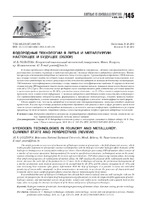| dc.contributor.author | Гольцова, М. В. | |
| dc.coverage.spatial | Минск | ru |
| dc.date.accessioned | 2019-01-10T12:35:06Z | |
| dc.date.available | 2019-01-10T12:35:06Z | |
| dc.date.issued | 2018 | |
| dc.identifier.citation | Гольцова, М. В. Водородные технологии в литье и металлургии: настоящее и будущее (обзор) = Hydrogen technologies in foundry and metallurgy: current state and perspectives (review) / М. В. Гольцова // Литье и металлургия. – 2018. – № 4 (93). – С. 145-154. | ru |
| dc.identifier.uri | https://rep.bntu.by/handle/data/48545 | |
| dc.description.abstract | В статье представлен обзор достижений водородной обработки материалов – области материаловедения, кото-
рая позволяет улучшить структуру и свойства материалов с помощью обратимого водородного воздействия. Показа-
ны примеры использования водородных технологий в литье и металлургии. Термоводородная обработка (ТВО) титановых сплавов состоит из ряда последовательных операций: наводораживание металла до заданных концентраций, технологическое воздействие на металл, вакуумный отжиг для удаления водорода из металла до безопасных концентраций. ТВО позволяет пластифицировать титановые сплавы, повышает их антифрикционные свойства. В сварных соединениях сплавов титана ТВО выравнивает пластичность сварного шва и основного металла, повышает циклическую долговечность изделий в 2,0–2,5 раза. В технологиях литья предварительное наводораживание ряда алюминиевых расплавов приводит к увеличению предела прочности на 20–30%, а относительного удлинения – на 15–45%, а также к возрастанию жаропрочности после пластической деформации. С помощью водородного воздействия можно осуществлять контролируемое порошкообразование интерметаллидов, формировать в материалах наноструктуру, ускорять процессы химико-термической обработки, а также вызывать «искусственный полиморфизм» в металлах, неполиморфных по своей природе. Сделан вывод о том, что часть водородных технологий уже коммерциализирована, часть еще ожидает широкого применения. В целом перспективы развития водородной обработки материалов лежат в сфере развития применения систем металл–водород, а международная активность, в частности, школы и конференции, традиционно и регулярно проводимые по этой тематике, позволяют судить о интенсивном развитии теории и практики водородных технологий. | ru |
| dc.language.iso | ru | ru |
| dc.publisher | БНТУ | ru |
| dc.title | Водородные технологии в литье и металлургии: настоящее и будущее (обзор) | ru |
| dc.title.alternative | Hydrogen technologies in foundry and metallurgy: current state and perspectives (review) | ru |
| dc.type | Article | ru |
| dc.identifier.doi | 10.21122/1683-6065-2018-4-145-154 | |
| local.description.annotation | The article presents an overview of achievements of hydrogen treatment of materials, – the field of materials science, which makes possible improvement of materials structure and properties with the help of a reversible hydrogen effect. Examples of the hydrogen technologies use in casting and metallurgy are shown. Thermohydrogen processing (THP) of titanium alloys consists of a number of successive operations: hydrogenation of the metal to specified concentrations, technological action on the metal, vacuum annealing to remove hydrogen from the metal to safe concentrations. THP allows plasticizing titanium alloys, increasing their antifriction properties. In welded joints of titanium alloys, the THP equalizes the plasticity of the welded joint and the base metal, increases the cyclic life of the products by 2–2.5 times. In the technologies of casting, the preliminary hydrogenation of a number of aluminum melts leads to an increase in the strength limit by 20–30%, and the relative elongation by 15–45%, and also increasing heat resistance after plastic deformation. With the help of hydrogen, it is possible to carry out controlled powdering of intermetallic compounds, to form nanostructures in materials, to accelerate the processes of chemical-thermal treatment, and to cause «artificial polymorphism» in metals that are not polymorphic by its nature. It is concluded that some of hydrogen technologies have already been commercialized, some are still waiting for wide use. In general, the prospects for the development of hydrogen processing of materials lie in the development of the application of metal–hydrogen systems, and international activity (in particular, schools and conferences), traditionally and regularly held on this topic, allow us to judge the intensive development of the theory and practice of hydrogen technologies. | ru |

